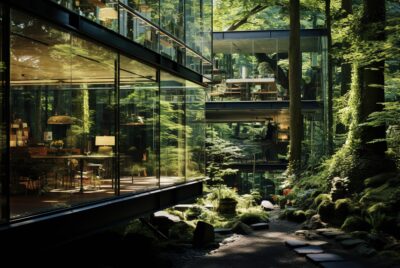Many design mistakes remain undetected until construction begins, which is why using 3D architectural renderings during the planning stage can help identify and address potential issues.
Creativity
3D architectural rendering is an intricate process. It requires both artistic talent and technical acumen. These combined skills are essential to achieve stunning results. Once complete, this powerful visualization tool allows us to transform abstract concepts into tangible forms that help shape our living environments.
3D architectural visualizations allow architects and designers to convey design features more realistically. This allows clients and project stakeholders to make more informed decisions more quickly. It also helps reduce errors that would otherwise arise. Ensuring that final projects reflect desired outcomes.
When creating architectural renderings, it is crucial to use high-quality components for an authentic experience. This includes textures and lighting, which play an integral role in conveying reality. For instance, a rough texture adds character. Dynamic lighting schemes provide movement while emphasizing shadows and highlights.
An essential aspect of architectural rendering is incorporating landscape elements to convey a sense of place, such as trees, grass and water features that will contribute to creating the overall feel of a design.
Techniques
Making an impressive 3D architectural rendering involves several essential steps. First comes creating the floor plan and customizing wall placement and dimensions. Next comes outlining exterior boundaries and terrain definition. Once this process has been completed, adding realistic details can take place. This includes tweaking grass areas, outlining elevation changes of areas outlined, and adding landscaping features as needed.
Final steps involve lighting and atmosphere design – this is where 3D rendering comes alive! By effectively applying these elements, architects can produce visually captivating representations of their projects.
Masters of 3D rendering know that to excel, one must constantly learn new styles and techniques. Industry leaders, such as Pixar’s work in Up, offer excellent examples for architects. Collaborating with other architects or 3D rendering experts provides additional opportunities to share ideas and develop your skills further.
Lighting
Lighting used in 3D architectural renderings can create the atmosphere and atmosphere of a building. Lighting plays an integral part in conveying what architects want their viewers to know about the design story they are telling through these renderings. Natural light makes a render appear more realistic. It also creates an environment that welcomes and comforts its inhabitants.
A good 3D architectural rendering should also demonstrate how the building will fit into its surroundings landscape. For instance, if the building will be located in an urban environment, such as a dense urban neighborhood, 3D architectural renderings can show how the building blends in seamlessly. This provides prospective tenants or investors with peace of mind. They will know that it will be easy for them to navigate and fit seamlessly with the city infrastructure.
When selecting a 3D architectural rendering service, it is crucial that they possess an established track record of producing superior work. An experienced professional will understand all the complexities of rendering processes more thoroughly. This deeper understanding makes them better equipped to solve issues. As a result, they can deliver results beyond expectations.
Colors
Color choices used in 3D architectural renderings add an eye-catching element to their final images, drawing attention to design details while giving more realistic renderings. Lighting techniques can further increase visual appeal.
Camera angle selection is also key when producing architectural renderings that capture their true essence. A common method is the straight-on street-level perspective, which emphasizes symmetry while making buildings appear more elegant and dramatic. Furthermore, this angle also serves to showcase both scale and detailed components of structures.
An architectural rendering should reflect its client’s vision perfectly; this ensures the end product satisfies any intended use, such as marketing a building or selling property. Therefore, architects and designers should make an effort to understand their client’s objectives and goals so they can craft visual representations that accurately encapsulate their creative vision while engaging an audience.
Perspectives
3D architectural renderings provide essential tools for communicating designs to clients clearly, such as exterior, interior, orthographic and aerial perspectives. These views help architects craft optimal layouts quickly while also highlighting potential problems to reduce costly miscommunication and save time in communication with them. This ultimately reduces costly misunderstandings while saving both time and money in unnecessary project delays.
Prior to 3D architectural rendering software being available, these images were drawn by hand (and some architects still do this today). This tedious process took considerable skill and time for completion – not always guaranteeing consistent quality drawings.
Architectural renderings have become a valuable resource in the architectural industry, serving design development, client presentations and marketing purposes. Thanks to user-friendly software that streamlines this process, creating 3D architectural renderings has never been simpler – freeing up resources for addressing other areas of design like identifying issues and making improvements more efficiently – enabling architects to craft high-quality 3D renders that tell compelling narratives while connecting with their audience.
Visit Our Site: The Crow Studio & Contact our expert for our services





